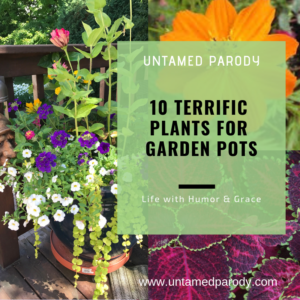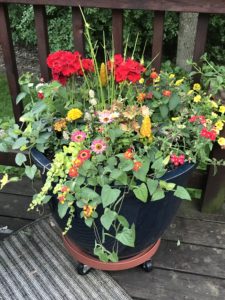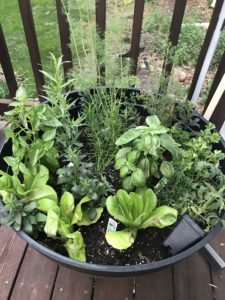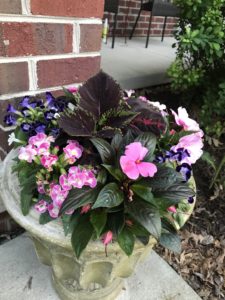

Full Sun: Creeping Jenny, Lantana, Geranium, Calibrachoa, Marigold, Shrimp Plant, Spike, Ganzia, Nicotania
I love creating beautiful garden pots, and tuck them throughout my home landscape. Scrolling through hundreds of Pinterest pins during our long, and often dreary, Wisconsin winters carries me through until spring when I can get down to the business of planning and planting. Generally, our planting season doesn’t safely begin until Memorial Day when we can be assured we won’t have overnight frost. Some years we’ve had a small miracle called early spring, and can plant up April and believe me, that’s a joyful day! I’m sitting squarely in Zone 4-5 on the USDA Hardiness Zone Map, but many of these plants are available at greenhouses around the country or by mail order. In some cases you might have a plant native to your neck of the woods that looks similar and is better suited to your zone. And, finally, some of the plants listed might be annuals in my zone, but perennial in yours.
Key things to remember when you’re building your pots:
- Pots should have a Thriller, a Spiller, and a Filler – a statement plant or two, plants that will flow over the sides of your pot, and something to fill in between plants to create a lush, full pot.
- If you’re planting huge pots, fill at least the bottom half of the pot with your best recyclable, milk jugs (I save them all winter. Rinse, lightly smash and store until spring). By doing so, you’ll save yourself money and an awful lot of dirt by not having to fill the entire pot. Because they’re plastic, they won’t break down. And, they provide a slow drainage route for water.
- I strongly recommend using a moisture helper potting soil, like Miracle Grow Moisture Control Potting Soil. If you’re like me and frequently forget to water your pots, this will help keep your plants from drooping between watering.
- Key is making sure water doesn’t pool in the bottom of your pots. Make sure your pots have holes in the bottom (believe it or not, not all pots have holes! Time for the drill!!) I always make sure there are 4-5 holes in the bottom of my pots, and vary the size based on the size of the pot. It’s super easy to over-water pots, especially if Mother Nature decides she’d like to help. Many a time I’ve not had enough drainage and watched my plants wash away or simply rot in place. Plastic or resin pots are easily drilled with just about any drill bit. Clay pots really should be done with a masonry bit to prevent cracking the pot.

Full Sun: Basil, Rosemary, Tarragon, Thyme, Fern-Leaf Dill, Oregano, Boston Bib Lettuce
- In my opinion, pot saucers do you no good. they tend to pool too much water. I ditch them. If you have access to saws and blocks of wood, simply cut squares of approximately 4″x4″x2″ thick and tuck those under your pots to raise them off the surface. Or, raise your pots on these little “pot feet“…so much easier!
- And for goodness sakes…if you have huge pots do NOT try to move them yourself! Either set them onto pot caddies before planting so you can wheel them around or get yourself a pot jockey.
- There’s no need to empty your pots at the end of a growing season unless you know you picked up a bug or fungus. Simply pull all plants out, turn the soil well, and you’re all set until spring. Over the years, I’ve changed over to outdoor pots made of sturdy, weather-resistant resin material. That way, I don’t need to bring the pots inside for the winter. Come spring, once the dirt thaws I simply turn it over once more and I’m ready for planting.
- Don’t forget….garden pots aren’t just for flowers! You can make fabulous vegetable and herb pots, too. In fact, every spring I build a giant, and delicious, herb pot that’s on a wheeled caddy right outside my patio door. I love having a handy assortment of fresh herbs to choose from.
- Finally, if you’re short on amazing annual plants in your area remember that you can pot perennials, too! Sometimes you want just the right plant or flower color, and a perennial fits the bill perfectly. Once the potting season is done, I plant the perennial in one of my flower gardens so I can continue to enjoy it year after year.
10 Terrific Plants for Garden Pots (zone 4-5)

Shade: Tuberous Begonia, Coleus, New Guinea Impatiens, Torenia
- Tuberous Begonia
- Choleus
- King Tut Plant
- Trailing Lobelia
- Lantana
- Creeping Jenny
- Zinnia
- Nicotania
- Gazania
- Calibrachoa
